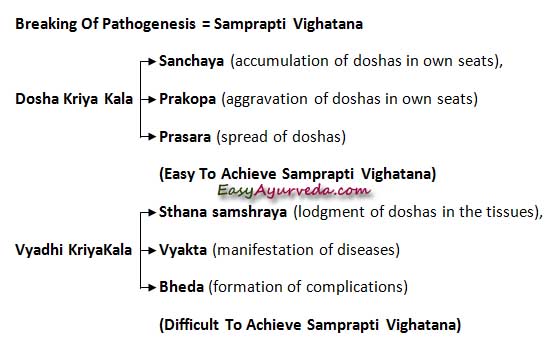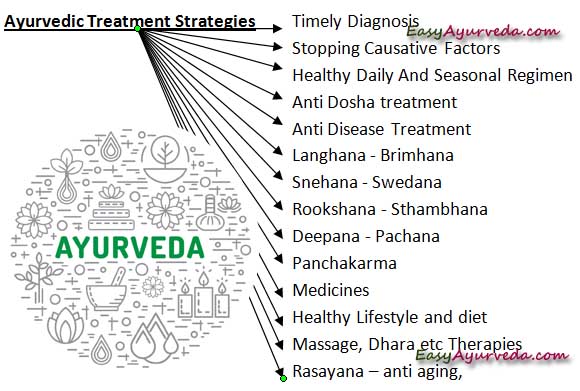Breaking Of Disease Pathogenesis: Meaning, Importance (Samprapti Vighatana)
Article by Dr Raghuram Y.S. MD(Ay)
Samprapti is a term which explains a series of events which ultimately leads to the formation of a disease in the body. It includes all the pathological responses and changes which occur in the body after a person gets exposed to or consumes Nidanas i.e. etiological factors of a disease to the complete manifestation of the disease.
In modern day language we equate it to a term called ‘pathogenesis’ which means birth of a disease or mechanism which leads to a diseased state.
The Nidanas (causative factors) lead to disturbance of doshas in the body. The vitiated doshas circulate all through the body and contaminate the body tissues leading to a pathological admixture of doshas and tissues and waste products. This damages the tissues and waste products and cause the disease (vyadhi or roga) in that tissue or the organ.
Related Reading – Samprapti
Vighatana means to break or to abort.
Samprapti Vighatana means breaking the disease process, bringing the pathogenesis to a halt, making it weak enough to progress towards the formation of disease.
Table of Contents
Samprapti Vighatana
According to Ayurveda, the disease develops in step ladder pattern which involves 6 different stages. These stages in which the disease forms are called ‘Kriya Kala’ or ‘Shat Kriya Kala’.
Related Reading – Kriya Kala – six stages of disease manifestation
In disease treatment
Samprapti Vighatana is Chikitsa or Treatment for a given disease
Breaking the pathogenesis is nothing but bringing a halt to the progression of disease process and ultimately aborting the formation of disease.
If pathogenesis has been completed and the disease is formed, the complex pathological admixture of morbid doshas and susceptible tissues (dosha dushya sammurchana) is broken by administration of suitable medicines, therapies, diet and lifestyle corrections so as to destroy or to take the doshas under control.
Later the doshas are flushed back from the tissues and organs into the gut from where they are removed through effective administration of cleansing treatments of Panchakarma, mainly emesis (Vamana) and purgation (Virechana).
The other types of Panchakarma cleansing treatments i.e. medicated enemas (Vasti), nasal medication (Nasya) and bloodletting (Raktamokshana) can also be administered as and when required.
Thus, breaking the Samprapti or the dosha-dushya-sammurchana is nothing but effective treatment.
Samprapti Vighatana can be considered in two stages of diseases i.e. during the first three stages of pathogenesis when only doshas are vitiated (dosha kriya kala) and in the final three stages of pathogenesis when the disease formation takes place (vyadhi kriya kala).

In Dosha Kriya Kala
Samprapti Vighatana in Dosha Kriya Kala
Sanchaya (stage of accumulation of doshas in their own seats),
Prakopa (stage of aggravation of doshas in their own seats) and
Prasara (stage of spread of doshas) are the dosha kriya kalas because during these stages of pathogenesis only dosha vitiation and spread take place. Symptoms of dosha aggravation are manifested but disease is not formed.
Here, the pathogenesis of disease is weak. Therefore the pathogenesis breakdown (samprapti vighatan) can be done easily. When samprapti vighatana is done in dosha kriya kala, the pathogenesis doesn’t progress to vyadhi kriya kala and hence the disease is not manifested. The samprapti of the disease can be halted by administration of dosha pratyanika chikitsa or dosha specific treatment in this condition.
Read related: Amshamsha Kalpana – Fractional Understanding Of Qualities Of Doshas In Disease
In Vyadhi Kriya Kala
Samprapti Vighatan in Vyadhi Kriya Kala
Sthana Samshraya (stage of lodgment of doshas in the tissues),
Vyakta (stage of manifestation of diseases along with its signs and symptoms) and
Bheda (stage of formation of complications) are the vyadhi kriya kalas because during the pathogenesis of these stages, the disease is formed with its signs and symptoms and in later conditions it presents complications.
In contrast to the Dosha Kriya Kala, the samprapti is stronger in this vyadhi kriya kala. Since the disease with symptoms or complications is formed, the vyadhi kriya kala is difficult to treat in comparison to the dosha kriya kala, i.e. the samprapti vighatana is difficult in vyadhi kriya kala.
When Samprapti Vightan is done in sthana samshraya stage, the disease is not formed since the disease doesn’t progress to vyakta stage.
Similarly when the samprapti vighatana or chikitsa is done in vyakta stage, the disease doesn’t progress to the bheda stage and thus complications are not formed.
Vyadhi Pratyanika Chikitsa or disease specific treatment is needed to address the disease and to induce samprapti vighatana in vyadhi kriya kala. Cleansing treatments or Panchakarma treatments, disease modifying medicines (aushadha), immune-modulators (rasayana), and good diet (pathya) will be needed to treat the disease in this condition.
Breaking Samprapti in Shat Kriya Kala
Samprapti Vighatana in Dosha Kriya Kala
Dosha Kriya Kala comprises of the first three stages of pathogenesis.
The first 3 stages of pathogenesis of a disease comprises of –
Sanchaya – Sanchaya means accumulation of disturbed doshas in their respective places. It is the first stage of pathogenesis. It is also called as samhati rupa vriddhi i.e. cumulative increase of doshas.
Prakopa – Prakopa means severe vitiation (aggracation) of doshas in their own seats. It is the second stage of kriya kala. It is also called as vilayana rupa vriddhi i.e. liquefaction of doshas.
Prasara – Prasara means spread of vitiated doshas from their seats towards other parts of the body, i.e. overflow of doshas trespassing into the territories of the body not belonging to them. This follows prakopa or liquefaction of doshas. The liquefied doshas leave their seats and spread out in the body in all directions i.e.
upwards (urdhwa gati),
downwards (adho gati)
and side wards (tiryak gati).
The doshas put into flow in prasara are in sought of a place for lodgment. This place may be an organ (koshta, koshtanga), tissue, vital organs (marma), bones or joints.
One should remember that the doshas in dosha kriya kala are either vitiated or put out of place into circulation but they have not yet got lodged in the tissues nor damaged the tissues. Therefore the disease has not yet begun.
Executing Samprapti Vighatana
Executing Samprapti Vighatana in Dosha Kriya Kala
Samprapti is weak in Dosha Kriya Kala – In the first three stages of Kriya Kala, the Samprapti is weak or in steady and slow progression. Here only the doshas are increased gradually until they overflow and reach other parts of the body. These stages are called Dosha Kriya Kala.
Samprapti Vighatan is easier in Dosha Kriya Kala due to weaker Samprapti – For a disease to be formed the vitiated doshas should invade the weaker tissues and the organs made up of these tissues and damage them. Since in the first 3 stages of pathogenesis the doshas are either increasing or spreading without getting into contact of the tissues, the disease is not formed. Therefore treatment of these stages or aborting the samprapti at this stage becomes easier.
Samprapti Vighatan in Dosha Kriya Kala avoids manifestation of Vyadhi Kriya Kala – In these stages if the doshas are taken into control and if they are not allowed to come into contact with the dushyas (tissues), the pathogenesis gets arrested and the vitiated doshas get pacified. They do not progress into successive stages of vyadhi kriya kala (to be explained ahead) and hence the disease is not formed.
Dosha Pratyaneeka Chikitsa in Dosha Kriya Kala – In Samprapti Vighatana during Dosha Kriya Kala, ‘Dosha Pratyanika Chikitsa’ or ‘specific treatments and remedies to pacify the vitiated doshas’ should be adopted. A thorough analysis and study of the vitiated dosha or doshas in a given disease will help in comprehensively carrying out this form of treatment.
Doshas get pacified and samprapti vighatana takes place if the person has good immunity – If the person is immune enough, and if the dinacharya (diurnal regimen) and rutucharya (seasonal regimen) are followed properly, the doshas do not progress from prakopa to prasara. Instead the vitiated doshas undergo spontaneous regression in the following season (season antagonistic to them) even without remedies or little intervention. This is called shamana of doshas.
Samprapti Vighatana initiated in the earlier stages will prevent the formation of successive pathological stages – When samprapti vighatana is done in the sanchaya stage, the doshas don’t proceed towards aggravation (prakopa). Similarly when the doshas are taken into control during the prakopa stage they do not tend to spread (prasara), in fact they get settled down due to suitable interventions or by properly following seasonal regimen.
Causes and effects of disease
Cause is Nidana and effect is the disease manifestation or Pathogenesis (Samprapti). Samprapti is the story and summary of the disease formation. The causative factors which lead to disturbances of body elements leading to the initiation and progression of disease process are called Nidanas (etiological factors). Samprapti starts after the consumption of causative factors. These causes lead to dosha disturbance which is a mandatory event in the formation of a disease.
Related Reading – Role of dosha in the causation of diseases
When not treated properly or when the Ritucharya or seasonal regimen is not followed properly, the doshas which have undergone primary vitiation (accumulation or sanchaya) will go on to aggravate further (prakopa) and in due course of time would spread all through the body (prasara). When these doshas find weak and susceptible tissues (dushyas), they get lodged in them and form a vicious and pathological amalgamation with them. This is called dosha dushya sammurchana (amalgamation of dosha and dushya).
This (sthana samshraya of doshas or lodgment of doshas in the tissues forming an amalgamation) is an important and mandatory event in the formation of a disease.
Related Reading – Dosha Dushya Sammurchana
Dosha Dushya Sammurchana in Sthana Samshraya leads to manifestation of purvarupas (premonitory symptoms of a disease) which indicate that a disease is about to manifest in future. When the dosha dushya sammurchana further strengthens the disease is formed (vyakta) with its signs and symptoms (rupas). This happens when sthana samshraya is not addressed with proper and timely interventions. When vyakta stage is not treated the complications are formed (upadravas) and this stage of disease becomes difficult to treat and is called as Bheda.
The entire train of events right from the consumption of nidanas to the manifestation of disease (vyakta) or its complications (bheda) is called pathogenesis. The steps from sanchaya to bheda are called kriya kalas (stages of formation of disease).

Treatment strategies in Samprapti Vighatana
Samprapti Vighatana means breaking the samprapti, ending the pathogenesis and destroying the disease. It also means to destroy and abort the dosha-dushya complex i.e. dosha dushya sammurchana. This can be achieved only by effective treatment of the disease at any stage. Thus Samprapti Vighatana is synonymous with treatment.
Below mentioned measures shall be implemented so as to cause an effective samprapti vighatana and hence provide a comprehensive treatment and healing to the ailing patient.
Timely diagnosis
Samyak Vyadhi evam vikriti vinishchaya –
Timely diagnosis of the stages of dosha vitiation (dosha kriya kala) and disease formation (vyadhi kriya kala) and timely treatment of the same is very essential to destroy samprapti of a disease effectively. When diagnosed in earlier conditions of pathogenesis and treated promptly with effective measures of intervention, the disease doesn’t progress to the successive stages.
Nidana Parivarjana
Nidana Parivarjana – discontinuing causative factors
Avoiding the causative factors responsible for vitiation of doshas and causation of disease pathogenesis (samprapti) is by itself half treatment. Keeping the causes of the diseases away will halt the disease process because of non-availability of factors which would further aggravate a vitiated dosha or established disease. The Nidanas not only cause a disease but also play the role of triggers to enhance the already existing disease condition or dosha vitiation. On one side while effective interventions are being given, if the person continues taking the Nidanas, the treatment will be a waste because the Nidanas will never allow the healing process. Therefore Nidana Parivarjana becomes an important contribution towards an effective Samprapti Vighatana.
Following Dinacharya and Ritucharya
Dinacharya and Ritucharya palana –
Strictly following the daily regimen (dinacharya) and seasonal regimen (ritucharya) will definitely contribute towards positive healing while teamed up with Samprapti Vighatana. Every physician should insist on a proper daily and seasonal protocol while treating. These measures will surely come in handy.
Dosha antagonistic treatment
Dosha Pratyaneeka Chikitsa means dosha specific treatment, targeted towards morbid doshas. Medicines, diet, lifestyle changes and therapies which mitigate or expel the morbid doshas should be implemented in dosha kriya kala. Dosha Kriya Kala includes the first three stages of pathogenesis i.e.
sanchaya (accumulation of doshas),
prakopa (aggravation of doshas) and
prasara (spread of doshas. In these three stages only dosha will be aggravated (or is in spread in case of prasara).
Therefore only dosha specific strategies are needed to combat morbid doshas. The samprapti vighatana takes place when the doshas are attended and they do not progress to form the disease. Since the disease has not been formed in this kriya kala, disease specific treatment is not needed generally. This is more specific for dosha kriya kala but can be skillfully included to combat the doshic vitiation even in vyadhi kriya kala.
Vyadhi antagonizing treatment
Vyadhi Pratyaneeka Chikitsa means disease specific treatment, targeted to abort the disease process. Medicines, diet, lifestyle changes and therapies which break the dosha-dushya sammurchana and provide comprehensive cure from the diseases should be implemented in vyadhi kriya kala. Vyadhi Kriya Kala includes the later three stages of pathogenesis (samprapti) i.e.
sthana samshraya (localization and lodgment of doshas in tissues),
vyakta (manifestation of disease) and
bheda (manifestation of complications of a disease).
Since the disease is formed with its signs and symptoms in this kriya kala, disease specific treatment is needed to destroy the samprapti of a disease i.e. to bring about an effective samprapti vighatana.
Langhana
Langhana – lightening therapy
Langhana means lightening therapies, treatments and medicines which would induce lightness in the body. Lightness is opposite of gurutva i.e. heaviness. Heaviness in the body depicts that certain activities have slowed down or that there are some blocks or that there is some pathology developing in the system. It often depicts sluggish (weak) digestion and formation of ama or intermediate products of digestion which is causing blocks in various channels of the body. On the other side lightness is one of the symptoms of recovery from any illness and re-establishment of health in the system. Langhana is of 10 types but most often upavasa rupa langhana i.e. fasting (total or partial) or light food consumption is advised. Langahana is administered to destroy ama or kapha or fat which generally cause heaviness in the body. This will help in samprapti vighatana when combined with effective medicines and lifestyle changes.
Deepana
Deepana – kindling the digestion strength
Deepana includes implementation of medicines and treatments which enhance metabolic fire (increase appetite). Feeling of good appetite and timely hunger is a sign of good health and good status of agni i.e. metabolic fire (sama agni). As long as the gut fire is good, the other fires dependent on it like dhatu agni (tissue fire) etc will also be healthy and balanced and thus contributing to good health. As the statement made by Vagbhata ‘Sarve api rogau mande agnau’ tells that all the diseases are caused due to weak fire, it shows the importance of balancing the fire in the system so as to maintain good health. Same principle is applicable during treatment of diseases. Ayurveda corrects agni and ama in the beginning phase of treatment of most systemic diseases. Thus deepana and correction of agni helps in samprapti vighatana. The fire established through administration of agni deepana medicines will help in restoring the metabolic balance and other physical activities of the body which were disturbed due to disease and thus helps in establishing good health.
Pachana
Pachana – getting rid of undigested materials
Pachana includes administration of medicines and treatments which help in digesting ama (enhance digestion). Ama is a byproduct of sluggish digestion (manda agni). When the belly fire is weak, the digestion becomes weak. The food is incompletely digested and as a result improperly processed juices (essence) of food are produced in the stomach. This is called ama. The ama when put into circulation post-digestion, blocks all the pathways including the srotases (channel and duct system of the body) of the body. Every cell will be blocked and all the functions will be mercilessly disrupted. Nutrition and essential components needed for constructive functions of the body will not be reaching their destined tissues. Removing the blocks by destroying ama, by administering ama digesting medicines (ama pachana), forms a key treatment strategy while implementing samprapti vighatana for many diseases.
Snehana, Swedana
Snehana and Swedana –
Snehana or oleation and Swedana or sudation are important purvakarmas (pre-treatment procedures) for panchakarma (five cleansing treatments) and also individual remedies for many diseases. Snehana and Swedana help to mobilize and bring the doshas from the tissues to the stomach. Snehana in the form of consumption of oral medicated fats (oils, ghee) and external therapies like abhyanga (massage with herbal oils) will help in increasing and bulging the toxins gathered in the cells and prepare them to get flushed out. Swedana when given after snehana will open up the channels blocked by kapha and ama and also other toxins and enable the free flow of doshas and toxins from the cells towards the stomach for further expulsion. From the stomach, the doshas are thrown out through administration of Vamana (therapeutic emesis) or Virechana (therapeutic purgation).
Note:
Snehana – oleation and Rookshana – Drying therapies
Sweadna – sweating and Sthambhana – stopping therapies
Langhana – Ligthening and Brumhana – weight gain therapies
These six are together called Shad Upakarma. These from integral part of Ayurvedic treatment strategies.
Dosha Avasechana
Dosha Avasechana (shodhana, panchakarma) –
Expulsion of morbid doshas (or doshavasechana) from the body is the most important part of interventions as far as samprapti vighatana is concerned. Treatment of any disease is not complete without flushing out the vitiated doshas from the body. Doshavasechana is achieved through administration of cleansing therapies (panchakarma therapies) to expel the morbid doshas. Shodhana includes the panchakarma therapies i.e vamana (therapeutic emesis), virechana (therapeutic purgation), vasti (herbal oil and decoction enemas), nasya (nasal medication to expel doshas from head, neck and sense organs) and raktamokshana (bloodletting). When the doshas are thrown out of the system through doshavasechana, the body will get cleansed. The activities of the body will be restored along with restoration of metabolism, strength and immunity. It prevents recurrences of diseases in future and contributes towards maintenance of comprehensive and optimum health.
Rasayana
Rasayana –
Rasayana means immune modulators (anti-ageing treatments, rejuvenators). They are administered to prevent the recurrence of diseases and to boost immunity. After doshavasechana, once the body becomes cleansed and when the body activities are put into normal rhythm and once the health is reestablished and restored, it is important to maintain that health in its optimum state. For this to happen, the Rasayanas should be administered. Rasayanas provide long term immunity and restoration of optimum health. Therefore rasayanas form an important follow up after optimum samprapti vighatana.
Bheshaja
Bheshaja – medicines
Bheshaja comprises of disease modifying medicines which help in treating the disease and help in samprapti vighatana. They are disease specific or dosha specific and should definitely be included during treatment of an active disease and also during follow up.
Pathya
Pathya – healthy diet and lifestyle adaptation
Pathya means the foods activities and medicines useful and protective to the patha or the channels and ducts of the body i.e. for the srotases, in a way compatible to the whole system, to all the cells and tissues of the body, to the body, mind and senses. Samprapti vighatana is not comprehensive and complete without the administration of suitable, balanced diet and activities which is conducive and compatible to an individual and avoidance of apathya i.e. incompatible and bad foods and lifestyle practices. Good foods, good lifestyle, stress management, good exercise etc may be included in pathya ahara-vihara.
Other treatment strategies
Other strategies in samprapti vighatana –
External treatments and methods mentioned in Dinacharya including abhyanga (massage), udwarthana (powder massage), dhara (stream pouring of medicated liquids on head and body to relieve stress and systemic disorders), murdni taila (treatments done on the head with medicated oils), etc will help in establishing comprehensive body-mind health by taking part in samprapti vighatana of psycho-somatic illnesses. Yoga and meditation will help.
Chikitsa Chatushpada
Ultimately it is Chikitsa Chatushpada which is the most important tool needed for effective Samprapti Vighatana –
Among all these the comprehensiveness and teaming up of Chikitsa Chatushpada members associated will all goodness is the most essential tool for the success of Samprapti Vighatana. The members of chikitsa chatushpada – four limbs of treatment are –
Bhishak (physician or health provider),
Rogi (patient or health seeker),
Dravya or Aushadha (medicines) and
Upasthatha (nursing staff, care takers, family and friends).
Click to Consult Dr Raghuram Y.S. MD (Ayu) – Email / Skype










